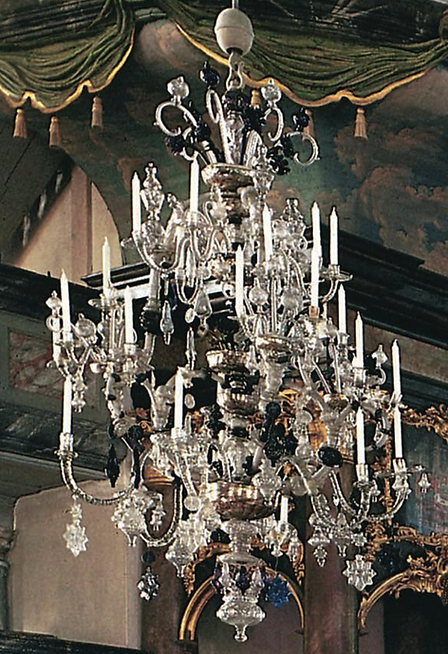Chandeliers from Nøstetangen
Masterpiece by master Köhler
It was the German glass artist Heinrich Gottlieb Köhler who designed the chandeliers in Kongsberg church. He came to Nøstetangen in 1756-57 and stayed there until 1770. The chandeliers in Kongsberg are characterized by Köhler's artistic lushness and attention to detail. There are colorful flowers, imaginative spiers and elephants in colored, pressed glass, symbols of the Danish Order of the Elephant.
Film below from Glasshytta and restoration of chandeliers at Kongsberg church:
Chandeliers
Glass chandeliers were the latest fashion in Europe and among wealthy Norwegians. Unfortunately, few chandeliers from Nøstetangen have been preserved, but there is much evidence that it was a significant product. Parts for chandeliers were sold separately so that you could put them together as you wished.
The special thing about the Norwegian chandeliers is that they were decorated with blown or cast elements, not ground prisms. Some of the pieces could be in dark blue or deep purple glass.
The three magnificent chandeliers in Kongsberg church were made at the works under Kôhler's management 1760–1766. Due to disagreements about the payment, they were first hanged in 1771.
They are far more complicated and colorful than the usual crowns from Nøsttangen and completely unique in their kind.


Spotlights on Glass
Randi Gaustad, National Museum of Art, Architecture and Design
The topic for ICOM Glass at the General Conference in Vienna was "Spotlights on Glass". In practice, chandeliers were the theme of the conference - chandeliers in an art historical context and restoration of chandeliers. An afternoon of lectures was arranged in collaboration with Light & Glass. European Society. Documentation Center for Chandeliers, an organization affiliated with the Museum of Art and Design in Prague.
I gave a lecture with pictures about the three chandeliers in Kongsberg church. They are quite unique in the European context because of their size, design and because they have hung in the same place for almost 250 years.
Kronene was ordered from Nøstetangen glassworks by the administration at the silverworks in 1759, while the church was still under construction. It was not so common to use chandeliers in glass in churches, but for the clients it must have been tempting to contact the glassworks because it was only a few kilometers away. From written sources we know that it was the engraver Heinrich Gottlieb Köhler who prepared the drawings for the chandeliers. In modern terminology, he was a designer, one of the first in Norwegian history. He was of German origin, but when in 1756 he was employed as an engraver and composer of chandeliers at the glassworks in Hokksund, he had been active as a court engraver in Copenhagen for 10 years.
There was another person who was important for the manufacture of the chandeliers. It was James Keith from England. Skilled glassworkers were highly sought after at the time, and Keith came to Norway after the glassworks director had sent an industrial spy to England to find out how the English lead crystal was made - and to persuade English professionals to move to Norway. Keith was a master at shaping glass in a hot state.
Together, these two foreigners made 3 wonderfully beautiful bright crowns that are unlike any other. What is special about them is, firstly, the shape, which is a combination of two known principles for chandelier construction, namely console chandeliers and basket-shaped suspension. Secondly, that the entire metal skeleton is covered with glass, glass tubes and spheres, and thirdly that the crowns are polychrome. Blue, manganese and green and yellow glass are used in them. The fourth unusual feature is that the decorative elements are blown and not sanded, which was the norm. What one might have expected was that the chandeliers were designed as a combination of English and German chandeliers, but instead they have similarities with Italian and French chandeliers.
What I hoped for when I presented the Kongsberg crowns to an international gathering of glass experts was, of course, that they would provide input on a solution to why the chandeliers look the way they do. No one had any suggestions for solutions, but we have established contact that may lead to something in the future.


